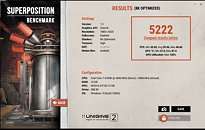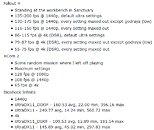Monday, December 11th 2017

NVIDIA's Latest Titan V GPU Benchmarked, Shows Impressive Performance
NVIDIA pulled a rabbit out of its proverbial hat late last week, with the surprise announcement of the gaming-worthy Volta-based Titan V graphics card. The Titan V is another one in a flurry of Titan cards from NVIDIA as of late, and while the healthiness of NVIDIA's nomenclature scheme can be put to the sword, the Titan V's performance really can't.
In the Unigine Superposition benchmark, the $3000 Titan V managed to deliver 5,222 points in the 8K Optimized preset, and 9,431 points on the 1080p Extreme preset. Compare that to an extremely overclocked GTX 1080 Ti running at 2,581 MHz under liquid nitrogen, which hit 8,642 points in the 1080p Extreme preset, and the raw power of NVIDIA's Volta hardware is easily identified. An average 126 FPS is also delivered by the Titan V in the Unigine Heaven benchmark, at 1440p as well. Under gaming workloads, the Titan V is reported to achieve from between 26% and 87% improvements in raw performance, which isn't too shabby, now is it?Poring through a Reddit discussion on the Titan V's prowess, the amount of benchmarks already in the wild is overwhelming, but a clear picture is easy to get: the Titan V is the world's most powerful gaming card at the moment, delivering a better experience in every setting, game, and workload (be it VR gaming or rendering) than any other GPU.
In Futuremark's VR Mark "Blue Room" benchmark, for instance, the Titan V easily delivers a score of 4,400 points - compared to the benchmark's own base premium high-end PC scores, that's a 1,428 points increase, delivering an above 90 FPS experience, something a GTX 1080 Ti wouldn't be able to achieve under the same settings. On the TimeSpy benchmark, the stock Titan V delivers 11,539 points, around 1,000 points more than the average 10,500 points a GTX 1080 Ti would achieve, paired with the same processor (there are higher 1080 Ti scores, yes; there are also lower.)The Titan V achieves an average of 65 FPS on max settings at 1440p; an average of 157 FPS on Gears of War 4 on Ultra settings at the same resolution; 76 FPS Average on 1440p, Crazy Preset of the Ashes of The Singularity Benchmark; and a slew of other gaming results that you'd do better in poring through yourself, including Deus Ex: mankind Divided, Fallout 4, XCOM 2, and others.We also have to remember that the Titan V can either be seen as the most expensive gaming graphics card that NVIDIA has ever sold, or as the best price/performance Volta-based computing graphics card. In general compute workloads the Titan V shines again, eking out victory after victory against NVIDIA's other gaming-capable offerings such as the GTX 1080 Ti. This is by no means an extensive coverage, but the Titan V has been benchmarked as delivering 41 seconds GPU time in the V-Ray benchmark, against the 107 seconds that a GTX 1080 Ti managed to deliver (with an equivalent CPU score). On SpecViewPerf 12.1, the Titan V delivers better performance than NVIDIA's professional Quadro P6000 (which goes for $5,000) across all workloads save one. This seems to be the best price-performance ratio for this graphics card, not gaming; so if you're looking for the best possible compute performance and the best gaming experience on the side, the Titan Volta is the only solution.
Sources:
Reddit User @hellotanjent, Joker Productions YouTube, Reddit User @Nekrosmas
In the Unigine Superposition benchmark, the $3000 Titan V managed to deliver 5,222 points in the 8K Optimized preset, and 9,431 points on the 1080p Extreme preset. Compare that to an extremely overclocked GTX 1080 Ti running at 2,581 MHz under liquid nitrogen, which hit 8,642 points in the 1080p Extreme preset, and the raw power of NVIDIA's Volta hardware is easily identified. An average 126 FPS is also delivered by the Titan V in the Unigine Heaven benchmark, at 1440p as well. Under gaming workloads, the Titan V is reported to achieve from between 26% and 87% improvements in raw performance, which isn't too shabby, now is it?Poring through a Reddit discussion on the Titan V's prowess, the amount of benchmarks already in the wild is overwhelming, but a clear picture is easy to get: the Titan V is the world's most powerful gaming card at the moment, delivering a better experience in every setting, game, and workload (be it VR gaming or rendering) than any other GPU.
In Futuremark's VR Mark "Blue Room" benchmark, for instance, the Titan V easily delivers a score of 4,400 points - compared to the benchmark's own base premium high-end PC scores, that's a 1,428 points increase, delivering an above 90 FPS experience, something a GTX 1080 Ti wouldn't be able to achieve under the same settings. On the TimeSpy benchmark, the stock Titan V delivers 11,539 points, around 1,000 points more than the average 10,500 points a GTX 1080 Ti would achieve, paired with the same processor (there are higher 1080 Ti scores, yes; there are also lower.)The Titan V achieves an average of 65 FPS on max settings at 1440p; an average of 157 FPS on Gears of War 4 on Ultra settings at the same resolution; 76 FPS Average on 1440p, Crazy Preset of the Ashes of The Singularity Benchmark; and a slew of other gaming results that you'd do better in poring through yourself, including Deus Ex: mankind Divided, Fallout 4, XCOM 2, and others.We also have to remember that the Titan V can either be seen as the most expensive gaming graphics card that NVIDIA has ever sold, or as the best price/performance Volta-based computing graphics card. In general compute workloads the Titan V shines again, eking out victory after victory against NVIDIA's other gaming-capable offerings such as the GTX 1080 Ti. This is by no means an extensive coverage, but the Titan V has been benchmarked as delivering 41 seconds GPU time in the V-Ray benchmark, against the 107 seconds that a GTX 1080 Ti managed to deliver (with an equivalent CPU score). On SpecViewPerf 12.1, the Titan V delivers better performance than NVIDIA's professional Quadro P6000 (which goes for $5,000) across all workloads save one. This seems to be the best price-performance ratio for this graphics card, not gaming; so if you're looking for the best possible compute performance and the best gaming experience on the side, the Titan Volta is the only solution.














71 Comments on NVIDIA's Latest Titan V GPU Benchmarked, Shows Impressive Performance
It's still impressive chip for scientific calculations tho.
My own testing with 1080Ti shows that it is already often enough CPU-limted at 1440p, especially at high FPS, for example on 144/165Hz gaming monitor.
Now, it would be really interesting to see a comprehensive set of Titan V benchmarks vs 1080Ti and on both AMD and Intel CPUs - i7 8700K and R7 1800X. Will even more raised GPU ceiling allow more cores spread their wings or is pure clock speed still what you would want.
As for whatever replaces the current lineup, history tells us the 80 non-Ti replacement should still beat the 1080 Ti.
Disappointing.
Love the new techpowerup forum skin btw!
People are welcome to game with it, it seems to do pretty well. But Nvidia can afford to create dedicated consumer focused GPUs.
It will be interesting to see how the GTX version performs and will hopefully outperform it by a few percent and at the same price as a 1080 Ti, or a bit less. Well, here's wishing on that price...
In addition , that was a transition from one architecture to another , they can easily afford to do that. Now they would have to re-engineering an already existing 800 mm^2 die. That's just simply not worth it , not matter how much cash they have.
Gv100 powers supercomputers like Summit and is for research institutions.
All else is tears in the rain.